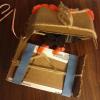Description: This is a very weird looking creature that pushes itself around using a single flat "foot." Its parts are held together by yarn (for stability) and pipe cleaners (to attach to the servo motor). The servo motor is held in place by yarn, which is attached to the folded parts of one piece of cardboard, which has pipe cleaner pieces on the bottom to help it slide. The other piece, attached with pink pipe cleaner, have elastics wrapped around them to provide grip. Using the basic Arduino potentiometer code, the crawler can propel itself forward with small motions.
Components:
- Arduino UNO + USB cable
- breadboard
- potentiometer
- servo motor
- 2 pieces of cardboard
- 2 wide elastics
- 4 small pieces of pipe cleaner
- 3 10" lengths of yarn or string
- masking tape (to secure servo motor)
Code:
/*
* Servo with Potentiometer control
* Theory and Practice of Tangible User Interfaces
* October 11 2007
*/
int servoPin = 7; // Control pin for servo motor
int potPin = 0; // select the input pin for the potentiometer
int pulseWidth = 0; // Amount to pulse the servo
long lastPulse = 0; // the time in millisecs of the last pulse
int refreshTime = 20; // the time in millisecs needed in between pulses
int val; // variable used to store data from potentiometer
int minPulse = 500; // minimum pulse width
void setup() {
pinMode(servoPin, OUTPUT); // Set servo pin as an output pin
pulseWidth = minPulse; // Set the motor position to the minimum
Serial.begin(9600); // connect to the serial port
Serial.println("servo_serial_better ready");
}
void loop() {
val = analogRead(potPin); // read the value from the sensor, between 0 - 1024
if (val > 0 && val <= 999 ) {
pulseWidth = val*2 + minPulse; // convert angle to microseconds
Serial.print("moving servo to ");
Serial.println(pulseWidth,DEC);
}
updateServo(); // update servo position
}
// called every loop().
void updateServo() {
// pulse the servo again if the refresh time (20 ms) has passed:
if (millis() - lastPulse >= refreshTime) {
digitalWrite(servoPin, HIGH); // Turn the motor on
delayMicroseconds(pulseWidth); // Length of the pulse sets the motor position
digitalWrite(servoPin, LOW); // Turn the motor off
lastPulse = millis(); // save the time of the last pulse
}
}


